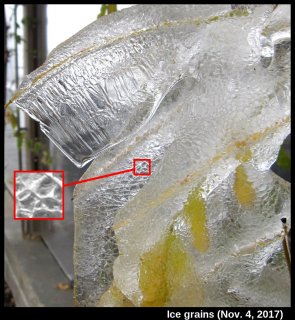| « That Snow Joke | Sheet icicles » |
Grain boundaries between crystals in big ice
Most snow crystals are single crystals. Being single is an outcome of their growth process and small size. On the other hand, most larger ice formations are not single crystals. These latter types are called "polycrystals". A polycrystal usually appears the same as any other type of ice -- smooth, uniform, clear or white -- just as if it were also single crystal. But the poly nature can be revealed when the ice warms to the melting temperature. At melting temperature, the boundaries between the separate crystals become visible. As an example, note the white lines in the ice in the inset in the image below.
(This image is from the ice drip complex in the previous post.) We call each individual crystal a "grain", and the boundaries between grains as "grain boundaries". The grain boundaries show up because the region has disordered ice that will melt at a lower temperature than regular ice. Thus, the light, upon passing through a grain boundary, will scatter more, making a whiter region, as shown in the image.
The ice is thus weaker on a grain boundary and has a tendency to break along these boundaries. On the surface of ponds and lakes, the grains (individual crystals) can be several inches or more across. So, if you get a sheet of such ice, and let it warm up to melting, you will find it easy to break the ice sheet along a grain boundary and thus isolate a large single crystal.
The size and pattern of the grains affect the mechanical properties of the ice. So, glaciologists, who want to know how a given glacier or ice sheet moves, are very interested in such patterns. They call this pattern the "ice fabric".
-JN
2 comments
Does all clear ice (not slush) sepatate or split as vertical candles or pencils? Or is there a difference in small grains and large grains? And what about air bubbles?

Hi Karel,
About your 1st question:
Does all clear ice (not slush) separate or split as vertical candles or pencils?
I have not seen polycrystalline ice that splits apart like this. Sea ice might, but I have not played around with sea ice. The reason sea ice might do this is that the salt in the water does not enter the ice, and tends to collect in long vertical channels called brine pockets.
About your 2nd question:
Or is there a difference in small grains and large grains?
The grains will depend on the ice history and the way it originally formed. Often, researchers just look at slices of the ice and thus get knowledge only of a cross-section. It would be interesting to know the 3-dimensional structure of the grains.
About your 3rd question:
Most ice formed from freezing has air bubbles. And there can be a lot of stress in the ice around the bubble. So this might lead to grains. I don’t know any more about it though.
(Sorry about the delay in this reply. I was having some trouble with the system.)
